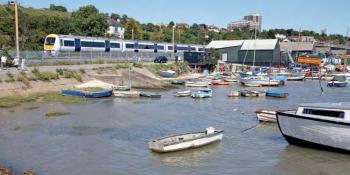
NETWORK RAIL has applied an insulating coating to the underside of a bridge in Cardiff to protect against flashover from the future Overhead Line Equipment (OLE). It also intends to fit surge arresters at the bridge to prevent any sudden spikes in voltage overcoming the protection provided by the coating.
The innovation is expected to save about £10 million on this bridge alone. If it is rolled out to other locations, the cost of electrification schemes could be significantly reduced because fewer bridges would require expensive and disruptive rebuilding. Network Rail is working closely with the Rail Safety and Standards Board and Office of Rail and Road on the innovation in Cardiff.
Network Rail’s Wales Route developed the solution for Cardiff Intersection Bridge, east of Cardiff Central. This is where the Valley Lines cross over the main line as they climb from Central towards Queen Street. Lowering the main line would be problematic because a large culvert, formerly a canal, passes below the main line at the same location.
Dave Hewings, the Route’s special projects manager, said the solution replaced the air-metal interface under the bridge with a 25kV insulating coating, manufactured by GLS Coatings of Mold, Flintshire.
‘In testing, the coating withstands the full line voltage without flashover, ie a zero mm clearance’, said Dr Hewings. ‘Additional protection is provided through the installation of surge arresters, which are standard power system devices used to limit transient voltage spikes and maintain the voltage to the level at which the coating provides full protection. The coating effectively changes the interface, which means that the clearance standards previously used no longer apply.’
He said there were impressive results from the combination of insulating coating, surge arresters and the Series 1 OLE underbridge design arrangement, which consists of twin contact wires and insulated bridge arms. ‘Its use in this way to mitigate bridge reconstruction is new, and this development on the Network Rail Wales and Borders Route is novel.’
‘Following the development of this idea, the coating has now been applied at Cardiff Intersection Bridge and we are working closely with the RSSB and ORR here, and on other sections of the main line, before it is brought into use’ Dr Hewings reports. Surge arresters have been used on power systems for decades.
Denmark has used them for 25kV rail applications. The solution for the Cardiff Intersection Bridge requires site-specific derogation and approval. Dr Hewings said a more generic acceptance in standards would be needed to ensure that the solution is safe on other types of bridges, and individual designs and risk assessments would then be applied. Rhodri Clark


